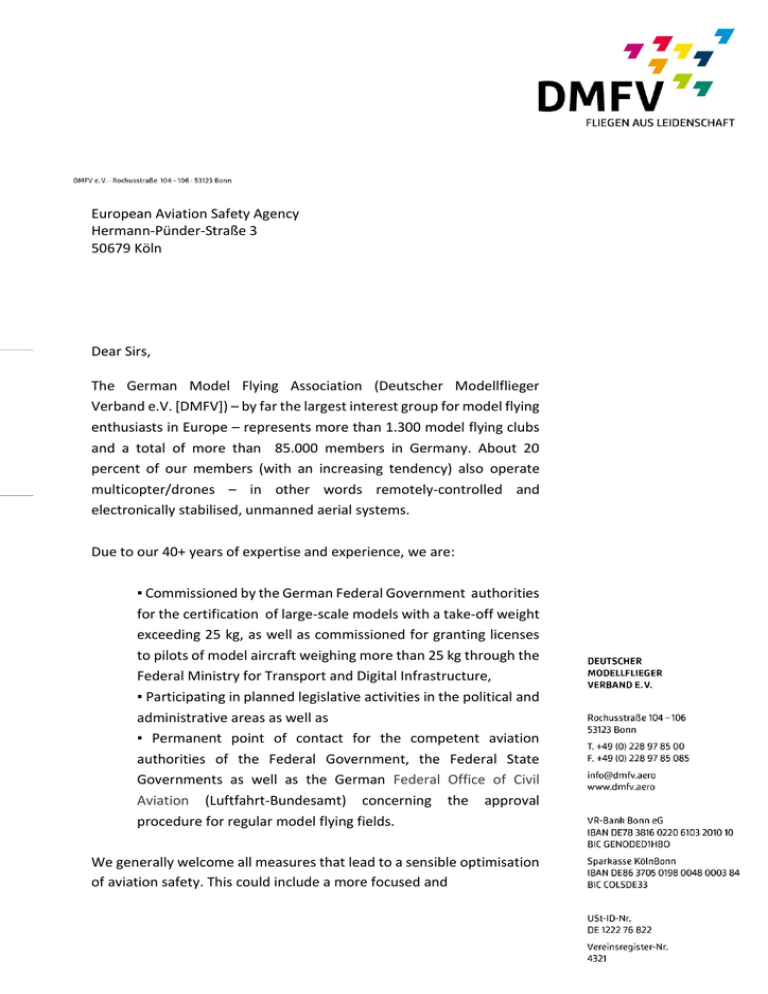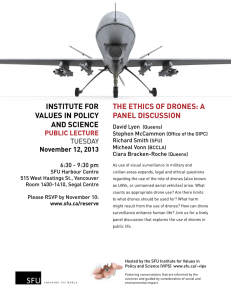European Aviation Safety Agency Hermann-Pünder-Straße
advertisement

European Aviation Safety Agency Hermann-Pünder-Straße 3 50679 Köln Dear Sirs, The German Model Flying Association (Deutscher Modellflieger Verband e.V. [DMFV]) – by far the largest interest group for model flying enthusiasts in Europe – represents more than 1.300 model flying clubs and a total of more than 85.000 members in Germany. About 20 percent of our members (with an increasing tendency) also operate multicopter/drones – in other words remotely-controlled and electronically stabilised, unmanned aerial systems. Due to our 40+ years of expertise and experience, we are: ▪ Commissioned by the German Federal Government authorities for the certification of large-scale models with a take-off weight exceeding 25 kg, as well as commissioned for granting licenses to pilots of model aircraft weighing more than 25 kg through the Federal Ministry for Transport and Digital Infrastructure, ▪ Participating in planned legislative activities in the political and administrative areas as well as ▪ Permanent point of contact for the competent aviation authorities of the Federal Government, the Federal State Governments as well as the German Federal Office of Civil Aviation (Luftfahrt-Bundesamt) concerning the approval procedure for regular model flying fields. We generally welcome all measures that lead to a sensible optimisation of aviation safety. This could include a more focused and factually justified regulatory framework for the new, independent type of drone users. Based on our extensive experience, this Advance Notice of Proposed Amendment (A-NPA) 2015-10 is questionable in terms of proportionally and effectively reaching the goals described therein. The majority of drone and model aircraft pilots exercise their hobby/model sport in a safe and responsible manner. Our members have clearly committed themselves to our statutory regulations regarding the protection of personal rights of third parties. We consent to the rules of A-NPA 2015-10 insofar as these are limited to autonomous drones as well as those drones that are operated beyond direct line of sight (BLOS). However, subject proposal does not include a definition for model aircraft which are operated and controlled within line of sight (LOS) and which are definitely not operated autonomous. Contrary to the primarily commercial operation of an autonomous drone, model aircraft are used for sports and leisure purposes. Therefore, in A-NPA 2015–10 we find no clear definition for the differentiation between autonomous drones and model aircraft/drones that meets the principle of legal certainty. This contradicts your selfmade declaration on Page 13: "The intention is to develop rules for the ‘open’ category that will not affect model aircraft flying." In this regard, also see your comments regarding "Special Operations" on Page 25. In particular, we are unable to find a clear statement for the unanimously agreed point between all parties, that the state-approved model flying fields must not fall under the regulatory framework. In addition, it is imperative that all model flying association members do not fall under this regulatory framework when they are performing sports or leisure activities at permitted locations. The members have been informed regarding the responsible use of drones, are subject to the associations' area of influence, and are therefore subject to an appropriate control mechanism. That being said, we would like to provide you with the following remarks to your Advance Notice of Proposed Amendment 2015-10: 1. Overall, the permission-free use of drones in Germany has not caused any noticeable interference regarding with third-party legal assets, nor has it led to any actual threats to air traffic. Any contradicting information has not been substantiated and is without a verifiable basis. This has also been documented by an internal evaluation at the end of 2014:"Accidents and incidents caused by model flying, including the operation of drones". DMFV – Damage overview model aircraft/drones: Damage Claims combined 2010 2011 2012 2013 2014 316 331 278 275 277 Damage caused by same RC frequency interference 29 22 9 4 2 Damage Personal injury caused by model mid air collisions 76 11 108 7 93 9 95 10 85 12 Details to damages caused by multicopter/drones: In 2013, only 7 of the 275 claims were caused by drone operations and recorded by the DMFV; in 2014, only 9 of the 277 damage claims were attributed to drones. In the aviation liability area, the DMFV is not aware of any damage claims in which personal injury was caused by a multicopter/drone. All registered claims were third party liability claims, where damage was caused to a vehicle or a building. One damage claim Claims as percentage of the number of members (rounded) 0.44% 0.44% 0.35% 0.34% 0.33% was filed because of a mid-air collision between two copter pilots who flew at the same time and then collided. Another collision occurred during a copter meeting on a model flying field. Otherwise, the majority of the damages caused by multicopters occurred outside of model flying fields. i.e. near or in residential areas. Details to damages caused by model aircraft: First, it should be mentioned that DMFV membership figures have increased from 72,400 (2010) to 83,700 (2014). Despite the increased number of model aircraft pilots – many of which joined the DMFV as individual members and are not organized in model flying clubs, i.e. usually do not fly from dedicated model flying fields – the number of damage claims went down significantly within the same period, falling from 316 to 277. The majority of accidents/incidents occur in those areas where a large number of model flying enthusiasts meet and fly together. Details regarding the cases of personal injury: These cases mostly involved slight personal injury with cuts and bruises; in rare cases there was an arm or leg fracture. Conclusion: Overall, the flying of drones as a sport or leisure activity in Germany – regardless of flying from model flying fields or other suitable areas – is one of the safest sport/leisure activities around. In order to preserve this situation, we have extended the application of the Luftverkehrsordnung (Air Traffic Order) § 16, Chapter 1, Number 1e) “Airspace requiring authorization for usage” to all cases, where drones are operated above crowds of people. The use of multicopters/drones as well as Unmanned Aerial Systems (UAS) operating above a crowd of people may cause a potential safety hazard. With subject legal regulation, we will be making a substantial contribution to cope with this specific issue and to prevent a potential safety problem, which so far has not been substantially proven by the rulemaking authorities. Please note: The DMFV is the only association in Europe which regulates damage claims in the area of model flying and drone operation on its own. Our damage statistics, which most likely will be similar in other European countries, provide a high level of significance and are also used by the German Federal Ministery of Transportation. The general low-risk caused by the operation of drones is also supported by the following statement: 2. The fundamental safety and the responsible operation of Unmanned Aerial Systems (UAS) and Remotely Piloted Aircraft Systems (RPAS) – also known as "drones" – is convincingly documented through a survey conducted by the responsible department LF 18 at the Federal Ministry for Transportation and Digital Infrastructure amongst the Aviation Authorities of the Federal States. The survey queried the registered increase in general and individual permissions for UAS and RPAS, as well as any information regarding accidents or serious incidents recorded in 2014. The total numbers of 2.623 granted general permissions, 1.594 granted individual permissions and 174 recognised permissions from other Federal States were opposed by just 21 registered incidents, from which some were actually caused by unauthorised flights. Based on this information, the German Model Flying Association appeals for a solution, that follows the principle of proportionality. This solution should reconcile the interests of the traditional model aircraft pilots and multicopter operators in the sports and leisure area, as well as those of the UAS/RPAS operators, while providing an adequate level of safety for third parties. Based on our evaluation, we do not believe that A-NPA 2015–10 is suitable, required and proportional in a narrower sense ("suitable") in order to bring the participating legal assets into a sensible relationship. Therefore, we suggest that – based on the comparable initial situation regarding traditional model flying – non-autonomous drones to be subjected to the tried-and-tested rules of model aircraft, i.e. the "open category" should be structured as such: - - - - - "Flying Line-of-Sight". This means, that the operator must always be able to clearly identify the object in the air without any technical assistance in order to be able to initiate a controlled manoeuvre at any time. A rigid 150-metre height limit is not required and also not suitable/noteworthy in order to attain the desired goals. Based on our experience, a clear notification that a manned aircraft always has the right of way would be sufficient. We strongly recommend a European-wide introduction of a mandatory special owner/operator third party liability insurance for all users of drones. A very important issue for the safe and responsible operation of drones is the legally manifested owner liability insurance for the operation of drones. As in Great Britain, it ensures that pilots are made aware ofthe fact, that this activity can potentially cause harm. On the other hand, this leads to a comprehensive information and awareness of the hobby pilots and therefore – in an ideal manner – ensures the goals that you have set with A-NPA 2015-10. The introduction of a mandatory information requirement for manufacturers, importers and associations – which conveys the most important fundamentals for participation in air traffic – should be, in particular, sent to all pilots. This especially applies to manufacturers/distributors of drones for commercial use. Thus, the provision of basic knowledge through the model flying associations of the member states as well as the model flying clubs in order to promote the "basic aviation awareness" desired. Flying over crowds of people should require authorisation. A safety distance of 50 meters in height must be ensured. The - lateral safety distance could be less than 50 meters provided safety nets or barriers are in place. A basic marking requirement, i.e. name and address or phone number, for drones must be implemented. The introduction of suitable technology, designed to prevent the operation in control zones and no-fly areas, requires further evaluation. In terms of Proposal 14 and the implementation of three sub-categories within the open category, we explicitly warn against the establishment of a sub-category of mini drones/toys with a weight up to 999 grams. In particular, model aircraft weighing less than 1 kg are predominantly flown by younger pilots or newcomers into the sport. It is imperative that safety regulations and the disclosure of risks are emphasised to these pilots. Regarding members in the associations or model flying clubs, it can be assumed that this transfer of knowledge takes place due to the mandatory insurance obligation. For the independent flying of drones, a sensible explanation and monitoring for the protection of third parties can primarily be ensured through the authorised model flying associations of the BMVI. The differentiation based on weight does not provide any valid indication to the flying ability or the flying characteristics of a particular model aircraft. Model aircraft weighing under 1 kg – even under 500 g – can fly just as far, fast or high as models above this weight; this applies to both drones as well as model aircraft, no matter which propulsion technology or control technology (e.g. radio controlled, Wi-Fi, infrared) is being used. Under these aspects, it is our opinion that the classification of all model aircraft as aircraft makes sense and a qualification of drones less than 1 kg as a toy must be refrained from. In our opinion, drones do not fundamentally create a problem for air traffic, but they are participants in air traffic and as such they represent a potential general operating danger, just like any other aircraft. However, if you insist that lightweight drones be classified as "toys", then we recommend that the wording of A-NPA 2015-10 should be changed in the appropriate location as follows: "Drones that have been designed or obviously have been meant to be used by children, or weigh less than 100 grams (0.100 kg) are classified as toys. Toys do not fall under the regulatory framework as per A-NPA 2015–10". For model aircraft weighing more than 5 kg, the current applicable national regulations are deemed sufficient. We do not recommend different weight limits for model aircraft (5 kg) and drones (4 kg). The weight limit of CAT A1 should therefore be increased to 5 kg. We welcome the intention to seek support for the National Aviation Authority through a "Qualified Entity" for the "Specific Category". As you can see from our input here, we are more than willing to cooperate in any way we can. We hope the information provided will be helpful. Please do not hesitate to contact us if you need further information or clarification on any of the points made. Best regards Hans Schwägerl Frank Weigand President Director Bonn, September 21, 2015




